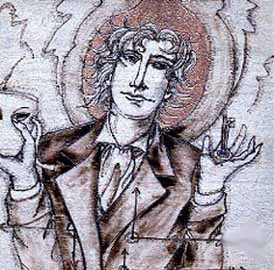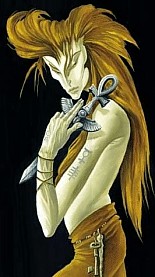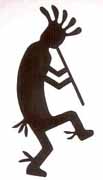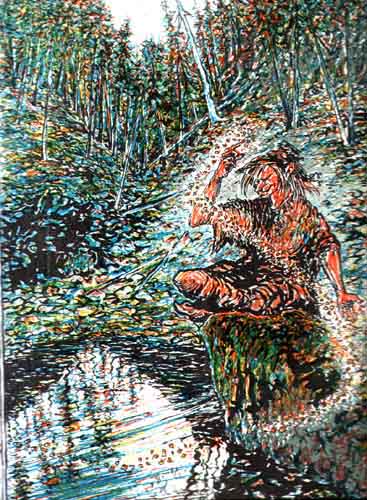



The trickster is an alchemist, a magician, creating realities in the duality of time and illusion.
In mythology, and in the study of folklore and religion, a trickster is a god, goddess, spirit, man, woman, or anthropomorphic animal who plays tricks or otherwise disobeys normal rules and conventional behavior. It is suggested by Hansen (2001) that the term "Trickster" was probably first used in this context by Daniel G. Brinton in 1885.
The trickster deity breaks the rules of the gods or nature, sometimes maliciously (for example, Loki) but usually with ultimately positive effects. Often, the rule-breaking takes the form of tricks (eg. Eris) or thievery. Tricksters can be cunning or foolish or both; they are often very funny even when considered sacred or performing important cultural tasks. In many cultures, (as may be seen in Greek, Norse or Slavic folktales, along with Native American/First Nations lore), the trickster and the culture hero are often combined. To illustrate: Prometheus, in Greek mythology, stole fire from the gods to give it to humans.
He is more of a culture hero than a trickster. In many Native American and First Nations mythologies, the coyote (Southwestern United States) or raven (Pacific Northwest and coastal British Columbia) stole fire from the gods (stars or sun) and are more tricksters than culture heroes. This is primarily because of other stories involving these spirits: Prometheus was a Titan, whereas coyote and raven are usually seen as jokesters and pranksters.
Frequently the Trickster figure exhibits gender variability, changing gender roles and engaging in same-sex practices. Such figures appear in Native American and First Nations mythologies, where they are said to have a two-spirit nature. Loki, the Norse trickster, also exhibits gender variability, in one case even becoming pregnant; interestingly, he shares the ability to change genders with Odin, who despite being nominally the chief Norse deity also possesses many characteristics of the Trickster.
The Trickster is an example of a Jungian Archetype. The Fool survives in modern playing cards as the Joker. In modern literature the trickster survivors as a character archetype, not necessarily supernatural or divine, therefore better described as a stock character.
In later folklore, the trickster is incarnated as a clever, mischievous man or creature, who tries to survive the dangers and challenges of the world using trickery and deceit as a defense. For example many typical fairy tales have the King who wants to find the best groom for his daughter by ordering several trials. No brave and valiant prince or knight manages to win them, until a poor and simple peasant comes. With the help of his wits and cleverness, instead of fighting, he evades or fools monsters and villains and dangers with unorthodox manners. Therefore the most unlikely candidate passes the trials receives the reward. More modern and obvious examples of that type are Bugs Bunny and The Tramp (Charlie Chaplin).
The trickster is an important archetype in the history of man. He is a god, yet he is not. He is the wise-fool. It is he, through his creations that destroy, points out the flaws in carefully constructed societies of man. He rebels against authority, pokes fun at the overly serious, creates convoluted schemes, that may or may not work, plays with the Laws of the Universe and is sometimes his own worst enemy. He exists to question, to cause us to question not accept things blindly. He appears when a way of thinking becomes outmoded needs to be torn down built anew. He is the Destroyer of Worlds at the same time the savior of us all.
The Trickster lives inside and outside of Time. He is of our world, yet not of our world, so our laws will not always apply. Other symbols, associated with him include keys, clock, masks, infinity among other mythological images
Trickster is a creator, a joker, a truth teller, a story teller, a transformer linked to the spiritual frequency changes humanity is experiencing at this time.
We seem most accessible to the synchronistic gifts of the Trickster when we ourselves are at or near boundaries or are experiencing transition states, periods of major life transitions seem to be occasioned by an abundance of meaningful coincidence. Personal growth sees not only to facilitate synchronicity, but in turn to be facilitated by it. As an archetype, the Trickster, the boundary dweller, finds expression through human imagination and experience.

We live in a dual reality, opposite polarities, yin /yang, male/female, good/ evil, God/Devil or Trickster. Our reality is created by electromagnetic energy fields, the poles (North and South), positive and negative energy. This is much like a game. In order to win the game you must create balance. You can beat the trickster if you ignore that which he brings as challenges.
Our soul spirals its consciousness into a physical body to experience different roles and emotions. The trickster 'stirs the pot' and creates the drama, to that end.
When you abuse someone, that is the trickster in you, showing itself. When you allow yourself to be abused, playing the victim, and remain stagnant in your life, the trickster aspect of you is in control.
The trickster seems to have supernatural powers which help him perform his tricks. He lives, dies, comes back, shape shifts, all sorts of magic as our reality is nothing more than an illusion. It is the mythology of our reality, birth, death, and rebirth from the ashes, the flame of creation.
There are times the Trickster brings lessons that we came into this experience. Trickster is almost always portrayed as male. In the duality he represents the lower emotions, lower chakras, that which gets us into mischief. This represents the aggressive side that deals with the lower frequency emotions, fate, jealousy, anger, self destruction, rage, depression and goes to mental illness.
Trickster is the emotional body, our Inner Child or wounded soul, who evolves in our lifetimes as it spirals back to higher light.
The concept of the Trickster is as much a part of humanity's history as the concept of God. All creational myths deal with polarity, good god vs. bad god, the duality of our nature and with each of us. To be emotionally challenged, is to listen to the voice of the trickster and live in a space of drama and negative emotions. To create balance is to live in the so-called 'god aspect' of who we are.
Physical reality is a game in which the Trickster challenges us at every turn. That is his role in the duality of this bio-genetic experiment in liner tome and emotion.
Trickster is the teacher, when you attract lessons into one's life. With his lessons, he awakens us to who we are and allows us to explore the true purpose of our soul's journey in the holographic experience through which we experience consciously at this level of awareness.
His energy allows us to break out of old stereotypes, whether they've been imposed by ourselves, our families, our culture, or circumstance. This is the energy that opens the world of limitless possibilities and it behooves us all to work with it before it destroys us, to touch the Trickster as he touches us.
Trickster is a teacher, survivor, hero, always traveling, outrageous and cunning, foolish and wise, mischievous and often doing good despite himself. He is a metaphor for the evolution of consciousness in the alchemy of time.
Eshu
In Yoruba mythology, Eshu is an Orisha, and one of the most respected deities of the tradition. He has a wide range of responsibilities: the protector of travelers, god of roads, particularly crossroads, the deity with the power over fortune and misfortune, and the personification of death, a psycho pomp.
Every magical ceremony or ritual began with an offering to Eshu; failure to do so guarantees failure in the intent of the ceremony. Within the Orisa'Ifa, Santeria/Lukumi religion developed by the descendents of enslaved West African, Eshu was identified with Saint Anthony or Saint Michael, depending on the situation.
He is identified by the Colours red and black, or black and white and his caminos, or paths (compare: avatar) are often represented carrying a cane, shepherd's crook, as well as a pipe.
Eshu is a trickster-god, and plays frequently tempting choices for the purpose of causing maturation. He is a difficult teacher, but a good one. As an example, Eshu was walking down the road one day, wearing a hat that was red on one side and blue on the other. Sometime after he departed, the villagers who had seen him began arguing about whether the stranger's hat was blue or red. The villagers on one side of the road had only been capable of seeing the blue side, and the villagers on the other side had only been capable of seeing the red half. They nearly fought over the argument, until Eshu came back and cleared the mystery, teaching the villagers about how one's perspective can alter one's perception of reality, and can be easily fooled.
(In many versions of this tale, the two tribes were not stopped short of violence; they actually annihilated each other, and Eshu laughed at the result, saying "Bringing strife is my greatest joy". Eshu is thus a prototype of the atheistic view of God's nature.)
Amaguq
Japanese Culture
Krishna
Loki Norse Mythology
Greek Mythology
He seems to have originated in French folklore. An extensive treatment of the character is the Old French Le Roman de Renart from around 1175, which sets the typical setting. Reynard has been summoned to the court of king Noble, or Leo, the Lion, to answer charges brought against him by Isengrim the Wolf. Other anthropomorphic animals, including Bruin the Bear, Baldwin the Ass, Tibert (Tybalt) the Cat, and Hirsent the She-wolf, appear to give testimony against him, which Reynard always proves false by one stratagem or another. The stories typically involve satire whose usual butts are the aristocracy and the clergy, making Reynard a peasant-hero character. Reynart's principal castle, Maleperduys, is available to him whenever he needs to hide away from his enemies. Some of the tales feature Reynard's funeral, where his enemies gather to deliver maudlin elegies full of insincere piety, and which features Reynard's posthumous revenge.
Character who originated in Middle Low German oral tradition. In the folk story, he is presented as a trickster who played practical jokes on his contemporaries. Although craftsmen are featured as the main victims of his pranks, neither the nobility nor the pope are exempt from being fooled by him.
Coyote
In some Native American traditions, Coyote impersonates the Creator, making humans out of mud and bringing into being the buffalo, elk, deer, antelope and bear. In these myths, Coyote-Creator is never mentioned as an animal, though he can and does meet his animal counterpart, coyote; and they walk and talk together, addressing the other as "elder brother" and "younger brother." In these traditions the spiritual and corporeal are brothers who always walk and talk together.
While coyotes (the animal) are certainly responsible for destroying some domestic livestock, they are important to the larger environment as scavengers and destroyers of rodents. They are omnivorous feeders; they prey on small animals, eat plant matter, carrion and garbage, and they sometimes though not regularly team up to hunt larger animals. They are an invaluable part of a healthy ecology and environment, which sustains all life, including that of domestic livestock.
That the livestock industry has waged a brutal, unrelenting and environmentally irresponsible slaughter (most of it at taxpayer, not industry, expense) of coyote for more than 100 years is as shameful and scandalous as it is unsuccessful, unnecessary and expensive. That coyote has persisted, prospered and expanded, both in numbers and range, since the livestock industry put a price on his head is an indication of why Old Man Coyote continues to live in the mythology and dreams of native America and in the literature and imagination of its more recent arrivals. Coyote Man is the primordial trickster/teacher of American lore.
Carl Jung, The Trickster Archetype, Coyote

Kokopelli is a fertility deity, usually depicted as a humpbacked flute player (often with a huge phallus and antenna-like protrusions on his head), who is worshipped by many Native American tribes in the Southwestern United States. Like most fertility deities, Kokopelli presides over both childbirth and agriculture. He is also a trickster god. Because of his influence over human sexuality, Kokopelli is often depicted with an inhumanly large phallus. Among the Ho-Chunk, this penis is detachable, and he sometimes leaves it in a river in order to have sex with girls who bathe there. Among the Hopi, Kokopelli carries unborn children on his back and distributes them to women (for this reason, young girls are often deathly afraid of him). He often takes part in rituals relating to marriage, and Kokopelli himself is sometimes depicted with a consort, a woman called Kokopelli-mana by the Hohokam and Hopi.
Manabozho or Hare of the Algonkian peoples
Cin-an-ev
Mannegishi
Raven
Tonenili
Bamapana
Attributes of Tezcatlipoca and Quetzalcoatl originally came from older traditions than the Aztecs: the Olmecs and the Toltecs. The Aztecs assimilated them in their religion, and the two deities were equated and considered twin gods. They were both equal and opposed.
Thus Tezcatlipoca was called "Black Tezcatlipoca", and Quetzalcoatl "White Tezcatlipoca".
In one of the Aztec accounts of the creation of the world, Quetzalcoatl and Tezcatlipoca joined forces to create the world. There was only the sea, and the monster of earth Cipactli. To attract her, Tezcatlipoca used his foot as bait, and Cipactli ate it. The two gods then captured her, and distorted her to make the land from her body. After that, they created the people, and people had to offer sacrifices to comfort Cipactli of her sufferings. Because of this, Tezcatlipoca is depicted with a missing foot, and the bone of his leg exposed. There are several nahuas accounts of how gods made self sacrifices to help humanity.
Tezcatlipoca kidnapped Xochiquetzal, the goddess of flowers, because he felt that he deserved her more than her husband, Tlaloc. He was also said to be married to Xilonen.As Mixcoatl, Tezcatlipoca invented fire by rotating the heavens on its axis as a drill. Omacatl and Titlacahuan, Tezcatlanextia, were also aspects of Tezcatlipoca.
An incorrigible prankster, the Saci will not cause major harm, but there is no little harm that he won't do. He will hide children's toys, set farm animals loose, torment dogs, and prevent chicken eggs from hatching. He may suck the blood of horses, like a vampire bat, and tie knots in their manes.
In the kitchen, the Saci may spill the salt, sour the milk, burn the bean stew, or drop flies into the soup. If a popcorn kernel fails to pop, it is because the Saci put a spell on it. Given half a chance, he will dull the seamstressÕs needles, hide her thimbles, and tangle her sewing threads. If he sees a nail lying on the ground, he will turn it with the point up. In short, anything that goes wrong, in the house, or outside it, may be confidently blamed on the Saci.
Besides disappearing or becoming invisible (often with only his red cap and the red glow of his pipe still showing), the Saci can transform itself into a Matiapere, an elusive bird whose melancholic song seems to come from nowhere. A Saci will not cross water streams, lest it will lose all his powers, a fact that will be undoubtedly useful to people who find themselves being pursued by one. If that happens, the victim should drop ropes full of knots; the Saci will then be compelled to stop and undo the knots, thus allowing his victim to escape. One can also try to appease him by leaving behind some cacha¨a, or some tobacco for his pipe.
He is fond of juggling live coals or other small objects and letting them fall through the holes on his palms. An exceedingly nimble fellow, the lack of his right leg does not prevent him from bareback-riding a horse, and sitting cross-legged while he puffs on his pipe. Every dust devil, says the legend, is caused by the spin-dance of an invisible Saci. One can capture him by throwing into the dust devil a rosary made of rosary bead plant seeds, or by pouncing on it with a sieve, reinforced by two crossed bamboo strips. With proper care, the captured Saci can be coached to enter a dark glass bottle, where he can be imprisoned by a stopper with a cross marked on it.
Kappa, Maui God of One Thousand Tricks
Every day, Maui watched human beings scramble to work, or plant, or cook, or make bark cloth in the few precious hours between sunrise and sunset. There was never enough time, the sun moved too fast, the people suffered. They had no choice but to eat their food raw.
Maui grabbed his rope and his grandmother's magic jawbone. With a quick flick of the rope, he lassoed the sun and beat the sun-god with the jawbone, until the golden one agreed to move more slowly across the sky. Then Maui looked closely at the sky itself. It hung way too low. With a mighty heave, Maui shoved the firmament up higher.
The Maui went fishing. His brother wouldn't share their bait, so Maui punched his own nose and used his blood to fish. He hauled in catches so big they became the Polynesian islands.
In mythology the pranks of the trickster seemed almost a compulsion, something they could not control. The trickster was usually blessed with a curiosity that led them into trouble, but also had a cunning wit to get them out of trouble. He played the Game! Humans would forgive the trickster, knowing that when the gods were plagued by the trickster's wit and arrogance, with the side effects sometimes beneficial to humans. We recognized that at the heart of the trickster was a savior. So even if Coyote caused a great flood because of a theft, he did lead the human race to a better world.
In oral traditions worldwide, a story of deceit, magic, and violence perpetrated by a mythical animal-human trickster. The trickster-hero is both creator god and innocent fool, evil destroyer and childlike prankster.

Trickster is at the same time, creator and destroyer, giver and negator, he who dupes others and who is always duped himself. He possesses no values, moral or social, is at the mercy of his passions and appetites, yet through his actions all values come into being. Many of the Trickster's traits were perpetuated in the medieval jester, and have survived in the Punch-and-Judy plays and in the clown.
Few mythological figures have such a remote origin in time and broad distribution among cultures as the one called Trickster. This character has long puzzled its commentators, largely because Trickster defies any purely rational or intellectual analysis. In fact, anyone who has studied any particular trickster story can testify to its disturbing undertones of perplexity and provocation.
Trickster contains a transcendent nature whose epic qualities are truly awesome. We can think, for example, of when Maui, the Polynesian Trickster, snares nothing less than the sun. Yet with all his enormous power he is enormously stupid, the fool of the ages, the epitome or personification of human absurdity.
In world mythologies Trickster's guises are legion; so much so that Joseph Campbell, has called him The Hero With A Thousand Faces.
This outlandish, yet remarkable being in human form, learns, grows in understanding, changes, and at a certain point in his adventuresome blunders, is transformed. Until that moment, however, Trickster keeps changing shape and experimenting with a thousand identities, including shifts in sex, in a seemingly never-ending search for himself.
During all this he inflicts great damage on those around him and also suffers innumerable blows, defeats, indignities, and dangers resulting from his thoughtless, reckless forays. On entering upon existence he is first seen as a blurred, chaotic, hardly unified being, having no self-knowledge or life-knowledge, despite his divine parenthood. It is only later on in his travels that Trickster emerges as a culture hero, demigod, and savior of peoples. But this occurs only after his transformation or self-integration takes place, and brings to the fore the great and epic qualities initially given him by his divine progenitor.
The unity of Trickster with Hero-Benefactor is clear in a great number of the mythoi. The hero must trick the gods of their wealth, steal it, and in some manner make it available to humankind. This heavenly treasure usually is "fire" or is related to it. Raven steals the gods' fire sticks. Maui goes against Mahu-ika, the guardian of fire, to get it and bring it back to the people. In Greek myth it is Prometheus who does this. The many references to the sun-snaring feat of Trickster-turned-Hero extend illustration of this development (Katharine Luomala, Oceanic, American Indian, and African Myths of Snaring the Sun, Bernice P Bishop Museum Bulletin 168, Honolulu, 1940; reprinted by Kraus Reprint Company, N.Y, 1971). The hero who deceives, slays, or by his "wiles" appeases the gods, is honored as a savior of the world.
Trickster's hero qualities were present from the very beginning. But they lay dormant, in seed, until he decided to exercise them, which he did only after a long and painful process of trial and error, growth and metamorphosis. For in all of his manifestations Trickster remains a primordial being of the same order as the gods, despite his prolonged sojourn in the human condition.
No matter how often scholars have analyzed this myth in the attempt to reduce it to any strictly rational value, it endures in all of its polyfaceted and multileveled grandeur. To restrict understanding of it merely to one or two of its features would be to rob us of its unusually important meaning. For serious reflection upon the myth in all of its world variety brings a conviction that it can refer only to the evolution of human consciousness and the full range of phases and multiple colorations which this implies. Yes, the evolution of our consciousness, but from a gigantic perspective and nothing less, one which carries us back to the fabulous illo tempore: into the night of time millions of years ago to the magic moment of first creation, that, dawn time "when first the world was born" and we "walked with the gods."
From the initial dimness of a consciousness newly-born, lacking any real integration of its components, and having forgotten his divine mission, we follow Trickster as his awareness steadily comes forth in ever greater measure. We watch as the self-knowledge of this inchoate entity develops, bringing with it strength, remembrance, and a firmer sense of identity, all this until, at a certain point, by capturing the fire of inner illumination from the gods, he gains a full measure of self-consciousness or self-recollection, and can act to benefit mankind. To use Jungian terms, the Unconscious within himself has been transmuted into the Conscious, bringing lucidity of spiritual vision of self and the universe.
Saturn, the grim reaper, rules responsibilities, restrictions, limitations, and the lessons you must learn in life. He does not deny or diminish imagination, inspiration, spirituality, or good fortune, but he does demand that these things be given structure and meaning. The karmic lessons we have come to experience and overcome in this lifetime are expressed by Saturn. Saturn is a great teacher if you allow it to be so. If you resist, then you feel like you have been dealing with the Trickster. It takes spiritual maturity to move beyond the challenges of the Trickster and to embrace Saturn the Teacher.

The Trickster weaves the Patterns of Reality in illusion of Time